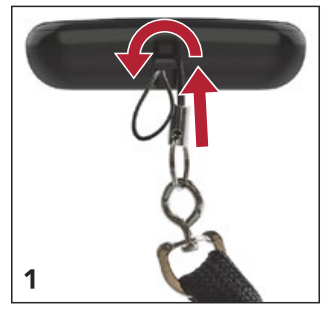 RemoteOPERATIONS MANUAL
RemoteOPERATIONS MANUAL

Introduction

The 2.4 GHz Remote allows for easy and discreet adjustments to your hearing aids.With its long battery life, the Remote is always ready to work with your hearing aids.
| 1. Ear Selection Switch | 5. Memory Change |
| 2. Volume Up | 6. Favorite |
| 3. Volume Down | 7. Home |
| 4. Mute/Unmute | 8. Lock/Unlock |
Pairing Process
For the Remote to interact with your hearing aid(s), you must first pair the Remote with each hearing aid. You only need to pair one time, as they should automatically recognize each other when both are powered on and within wireless operating range.
You can pair the Remote with a single hearing aid or a set of hearing aids.
To start using the Remote:
 Move lower switch from Lock (right) to Unlock (left) position.
Move lower switch from Lock (right) to Unlock (left) position.- Power off, then power on your hearing aid(s), and place within 12 inches of the Remote.• Note: For a CROS hearing aid system, power off both your hearing aid and CROS transmitter. Power on only your hearing aid, ensuring the CROS transmitter remains powered off.
- Press and hold the HOME button for 5 seconds.

- After 5 seconds, both LEDs start rapidly blinking.

- For a set of hearing aids:• If the left LED becomes solid blue for 2+ seconds and the right LED becomes solid red for 2+ seconds, then the pairing was successful. Otherwise, repeat steps 2 – 5.For a single left hearing aid:• If the left LED becomes solid blue for 2 seconds, then the pairing was successful. Otherwise, repeat steps 2 – 5.For a single right hearing aid:• If the right LED becomes solid red for 2 seconds, then the pairing was successful. Otherwise, repeat steps 2 – 5.
- To verify your setup, pressing the Volume Up or Volume Down button should cause a hearing aid volume adjustment.

Ear Selection Switch

The Ear Selection Switch controls whether adjustments are made to one hearing aid or both hearing aids.Set of Hearing Aids: To adjust both hearing aids at the same time, position the switch in the center.Single Hearing Aid: The switch is ignored, as the Remote always sends the appropriate left-side or right-side command.
LEDThe blue LED blinks when a button press command is sent to the left hearing aid. Similarly, the red LED blinks for the right hearing aid.
Volume Up/Down![]()
Short Press: The overall level of all sounds coming through your hearing aid microphone changes in the selected direction (either up or down).
Long Press: If streaming audio from a 2.4 GHz accessory, the audio stream volume changes in the selected direction (either up or down).
Home
![]()
To reset your hearing aids to memory one and the default volume level, press the Home button.
Lock/Unlock

To make adjustments to your hearing aids, the Remote should be in the Unlock state. When not using your Remote, you can lock it to prevent inadvertent hearing aid changes and to extend its battery life.
Mute/Unmute
 To temporarily turn off sounds coming through your hearing aid microphone, press the Mute/Unmute button. To unmute the hearing aids, press the button again.
To temporarily turn off sounds coming through your hearing aid microphone, press the Mute/Unmute button. To unmute the hearing aids, press the button again.
NOTE: When the hearing aids are muted, selecting any button will unmute the hearing aids as well as perform the function of the button selected.
Memory Change Your hearing professional may create multiple memories within your hearing aid. These additional memories can be accessed by pressing the Memory Change button, which will cycle through the available memories.
Your hearing professional may create multiple memories within your hearing aid. These additional memories can be accessed by pressing the Memory Change button, which will cycle through the available memories.
Favorite

Your hearing aids have the following Favorite button confi guration:None – Pressing this button has no effect on hearing aids.Stop/Start Audio Stream – Pressing this button starts (or stops) audio streaming from a 2.4 GHz accessory.Comfort Boost – Pressing this button reduces noise while optimizing sound quality in noisy environments. Press the button again to deactivate this feature.Jump to Memory 4 – Pressing this button moves the hearing aid to memory four.Tinnitus Stimulus On/Off — Pressing this button starts (or stops) playing a tinnitus stimulus through your hearing aids.
NOTE: Some of these features may not be available in all hearing aids.
Lanyard (optional)1. Insert the thin cord into the end of the Remote housing until the loop is exposed.2. Thread the lanyard through the loop and pull the lanyard.NOTE: Lanyards (part #90974-000) can be obtained from your hearing professional.
 |
 |
Troubleshooting
| SYMPTOM | POSSIBLE CAUSES |
SOLUTIONS |
| LEDs do not illuminate when button is pressed. | The Remote is in locked state. | Move lower switch from Lock (right) to Unlock (left) position. |
| LEDs illuminate, but hearing aids do not respond to a button press. | After moving lower switch to Unlock position, it may take a brief time to wirelessly “locate” your hearing aids. | Wait for about a second after unlocking before pressing a button. |
| Hearing aids are not paired with the Remote. | Perform pairing process with your hearing aids and Remote. | |
| Battery level in hearing aid can no longer support wireless activity. | Install new hearing aid battery. | |
| Set of hearing aids fail to pair with the Remote | Less than two hearing aids were found during
pairing process. |
During pairing process, make sure both hearing aids are available. |
| Only one hearing aid is receiving commands. | Ear selection switch is in the left or right position. | Move ear selection switch to center (both) position. |
Regulatory Notices
![]() Required InformationWaste from electronic equipment must be handled according to local regulations.
Required InformationWaste from electronic equipment must be handled according to local regulations.
Instructions for Disposal of Old ElectronicsStarkey Hearing Technologies encourages, and your local community laws may require, that your Starkey Hearing Technologies Remote be disposed of via your local electronics recycling/disposal process.
The below instructions are provided for the benefit of disposal/recycling personnel. Please include this manual when disposing of your Remote.
For Disposal/Recycling Personnel OnlyThis product contains a Lithium Ion Polymer battery.To remove this battery:
- Pry apart the housing halves with a small screwdriver.
- Unplug the battery connector from the circuit board to prevent accidental shorting.
- Pry the battery away from the housing using a wide flat blade. Intended Use The Remote is an accessory to a wireless air conduction hearing aid. It is intended for a user to remotely make volume and program adjustments to an air-conduction hearing aid.
The Remote is classified as a Type B applied part under the IEC 60601-1 medical instrument standard.
The Remote is designed to comply with the most stringent Standards of International Electromagnetic Compatibility. However, it is still possible that you may experience interference caused by power line disturbances, airport metal detectors, electromagnetic fields from other medical devices, radio signals and electrostatic discharges.
The Remote is designed to be cleaned with a damp cloth moistened with soapy water.
If you use other medical devices or wear implantable medical devices such as defibrillators or pacemakers and are concerned that your Remote might cause interference with your medical device, please contact your physician or the manufacturer of your medical device for information about the risk of disturbance. The Remote should not be used during an MRI procedure or in a hyperbaric chamber. The Remote is not formally certified to operate in explosive atmospheres such as may be found in coal mines or certain chemical factories.
Use on AircraftsThe Remote should not be used on aircrafts unless specifically permitted by the flight personnel.
International UseThe Remote is approved to operate at radio frequencies that are specific to your country or region and might not be approved for use outside your country or region.
Be aware that operation during international travel may cause interference with other electronic devices, or other electronic devices may cause interference with yourRemote.
The battery in your Remote is not replaceable. Do not attempt to replace the battery.The Remote is designed for the following temperature ranges:
- Operating: -20°C to +60°C (-4°F to 140°F), humidity < 95% non-condensing
- Storage: -40°C to +60°C (-40°F to 140°F)
We are required by regulations to provide the following warnings:
WARNING: Use of the Remote directly next to other electronic equipment should be avoided because it could result in improper performance. If such use is necessary, note whether your hearing aids and the other equipment are operating normally.
WARNING: Use of accessories, components, or replacement parts other than those provided by the manufacturer of the Remote could result in increased electromagnetic emissions and decreased electromagnetic immunity and could result in degradation of performance.
WARNING: If Portable Radio Frequency communications equipment is used closer than 30 cm (12 inches) from your Remote, degradation of the performance of your hearing aid could result. If this occurs, move away from the communications equipment.
Wireless Technical DescriptionThe Remote operates in the 2.4 – 2.4835 GHz band with a maximum effected radiated power of 3dBm with transmission modulation type of 1M06F1W. The receiver section of the radio has a bandwidth of 2 MHz.
The Remote has been tested to, and has passed, the following emissions and immunity tests:
- IEC 60601-1-2 radiated emissions requirements for a Group 1 Class B device as stated in CISPR 11.
- RF radiated immunity at a field level of 10 V/m between 80 MHz and 2.7 GHz as well as higher field levels from communications devices as stated inTable 9 of IEC 60601-1-2.
- Immunity to power-frequency magnetic fields at a field level of 30 A/m.
- Immunity to ESD levels of +/- 8 kV conducted discharge and +/- 15 kV air discharge.
The Remote has a rating of IP 5X per IEC 60529. This means that the Remote is protected from dust.The Remote does not contain any user-serviceable parts.Do not open or modify this device.Do not connect the Remote to any external device.The expected service life of the Remote is 3 years.
FCC/IC Information
FCC ID: EOA-24WRIC: 6903A-24WR (Model 610)FCC/IC NoticeThis device complies with part 15 of the FCC rules and with Industry Canada’s license-exempt RSS standard(s). Operation is subject to the following two conditions: (1) This device may not cause harmful interference, and (2) this device must accept any interference received, including interference that may cause undesired operation of the device.
NOTE: The manufacturer is not responsible for any radio or TV interference caused by unauthorized modifications to this equipment. Such modifications could void the user’s authority to operate the equipment.
Hereby, Starkey Hearing Technologies declares that Starkey Hearing Technologies Remote is in compliance with the essential requirements and other relevant provisions of Directive 2014/53/EU. A copy of the Declaration of Conformity can be obtained from the addresses below and from docs.starkeyhearingtechnologies.com
 Starkey Hearing Technologies 6700 Washington Ave. South Eden Prairie, MN 55344 USA
Starkey Hearing Technologies 6700 Washington Ave. South Eden Prairie, MN 55344 USA
 Starkey Laboratories (Germany) GmbH Weg beim Jäger 218-222 22335 Hamburg Germany
Starkey Laboratories (Germany) GmbH Weg beim Jäger 218-222 22335 Hamburg Germany
![]()
The following symbols are used in this document and on the Remote:
 Produces and receives radiofrequency energy.Interference may occur in the vicinity of equipment marked with the following symbol.
Produces and receives radiofrequency energy.Interference may occur in the vicinity of equipment marked with the following symbol.
![]() Dispose of properly
Dispose of properly
Notes
The Starkey logo and Starkey Hearing Technologies are trademarks of Starkey Laboratories, Inc.© 2019 Starkey. All Rights Reserved. 86163-007 12/19 BKLT3000-03-EE-SG
References
[xyz-ips snippet=”download-snippet”]


 Move lower switch from Lock (right) to Unlock (left) position.
Move lower switch from Lock (right) to Unlock (left) position.